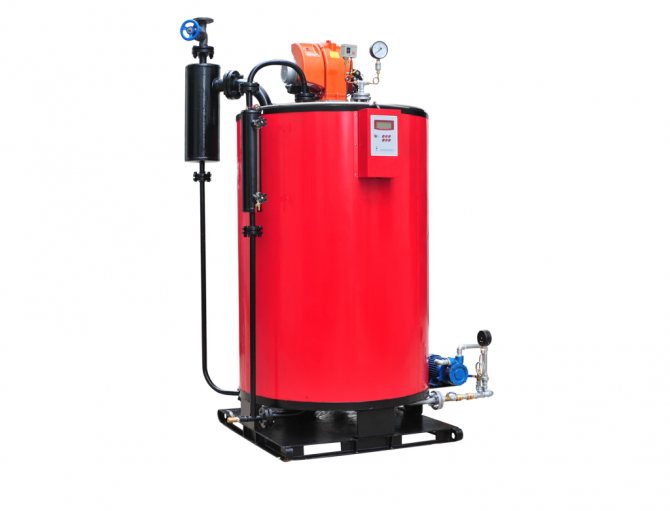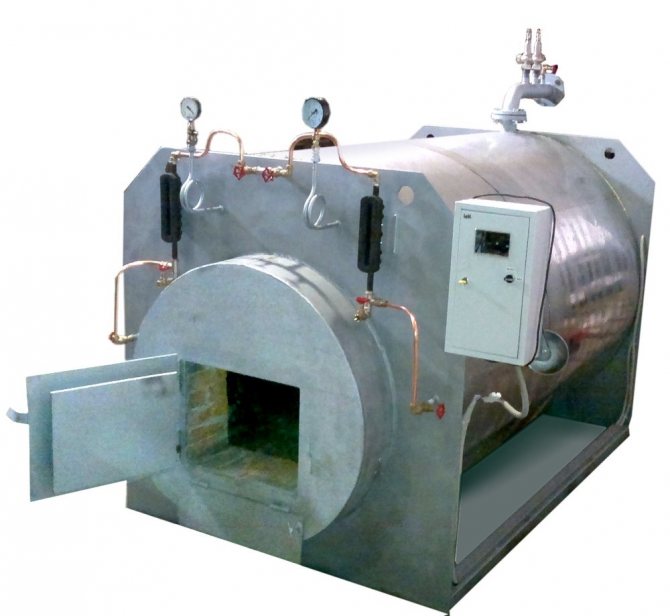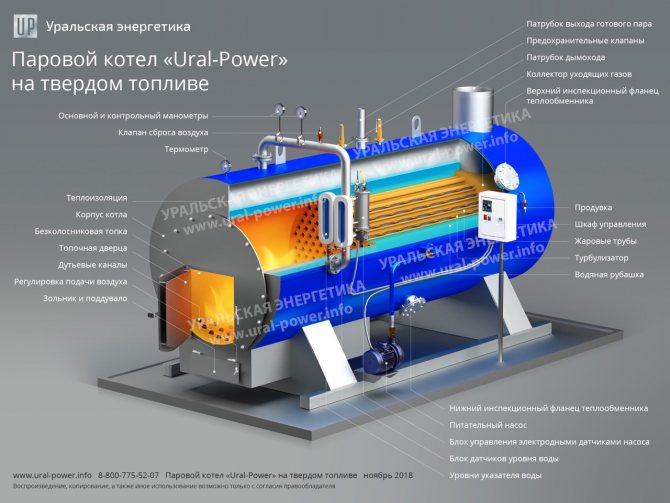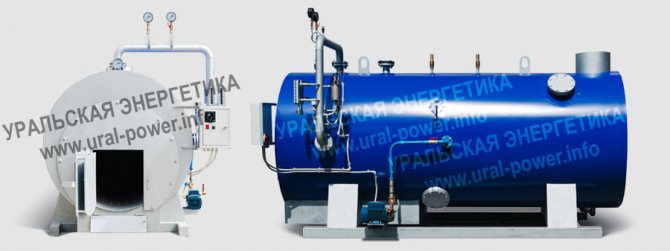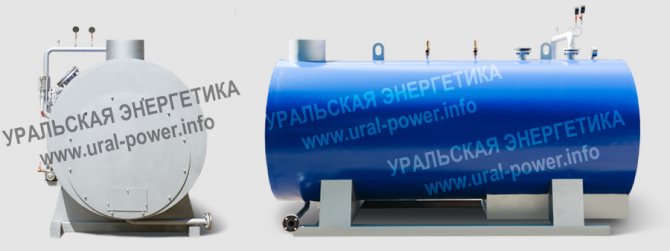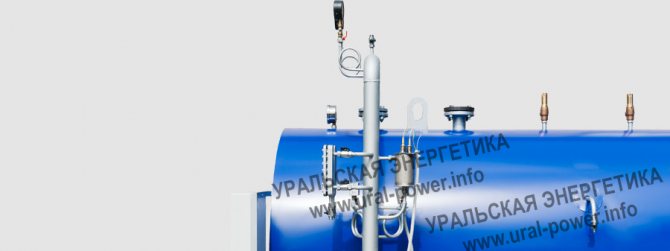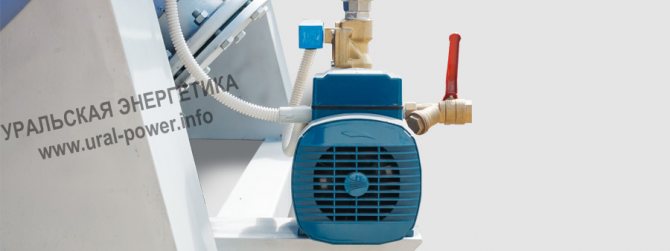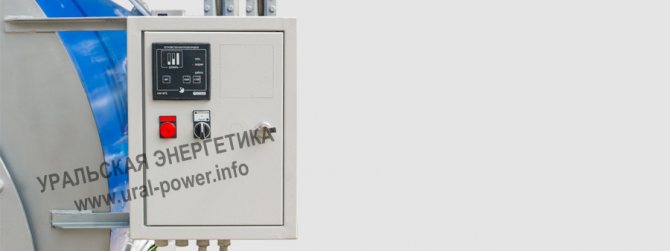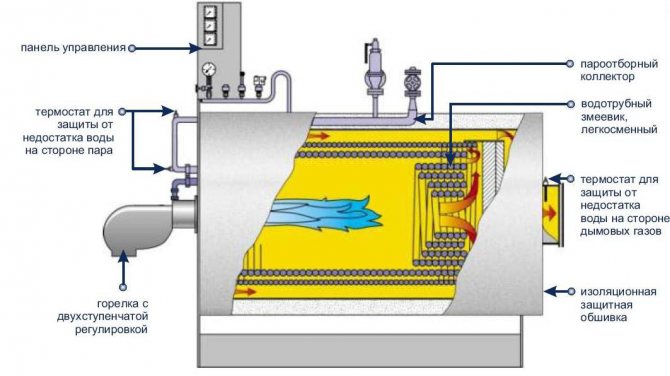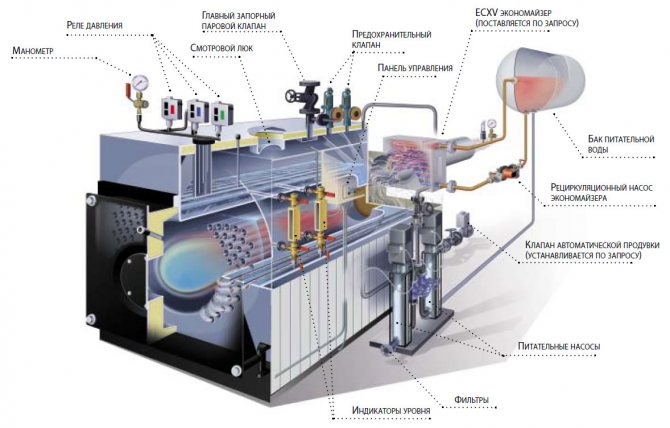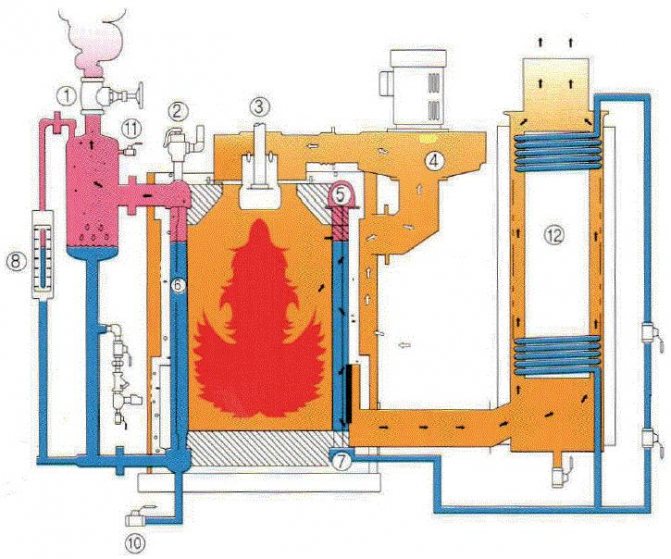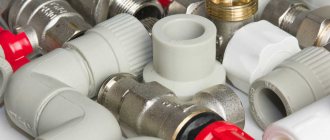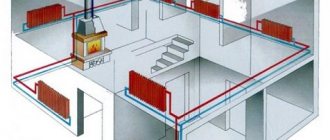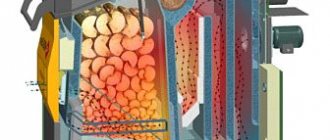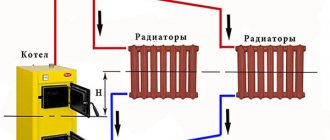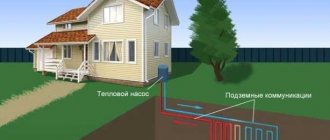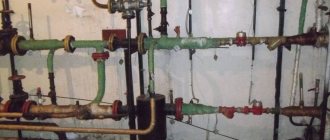Installation of solid fuel steam boilers
The design of solid fuel steam boilers is a single-fire horizontal box, consisting of two cylindrical sectors of different diameters. These cylinders are inserted into one another and connected by flanges and a steam collector. Thus, a firebox is located in front of the fire tube, and a bundle of pipes in the back. The principle of operation of solid fuel steam boilers is based on the heat exchange of liquid and gas. During the combustion of fuel, high temperature flue gases are formed in the fuel part of the boiler unit. Passing through the gas ducts, streams of hot smoke wash around the tube bundles in which the water circulates. Thus, gases transfer thermal energy to water, and they themselves are cooled from contact with cold pipes. As a result, the heated water in the pipes releases steam, which accumulates in the upper drum of the boiler.
The boiler is controlled by instrumentation and boiler automation. Auxiliary devices monitor changes in water temperature and pressure, and the boiler room automation ensures the safe operation of devices due to built-in sensors.
Steam boiler manufacturing technology
What is needed to make such a system?
- 1 mm stainless steel sheet metal.
- Pipes of various diameters from stainless steel - 100–120 mm, 10–30 mm.
- Safety valve.
- Asbestos in the form of sheets.
First of all, you need to get the blueprints for the steam boiler. This is not a problem today, since they are freely available on the Internet. The second task is to determine the power of the device. Everything will depend on the steam heating system, the size of a private house, the number of radiators in it, and so on. Other articles on our website will help you deal with this issue. Third, you need to choose the shape of the unit. It can be round, square or rectangular.
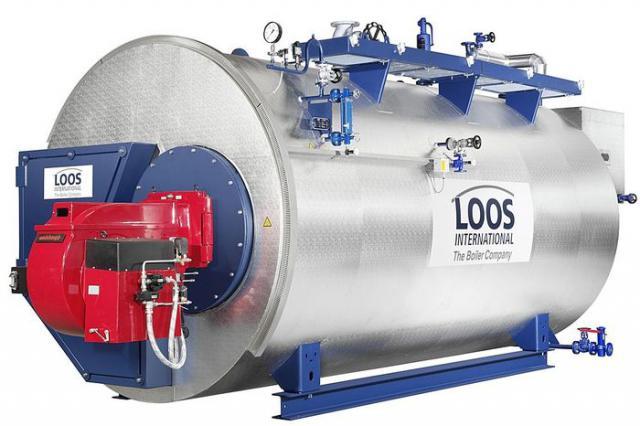
High pressure steam boiler
For ease of manufacture, you can take a pipe 100-110 cm long. It will be the body of the unit. Please note that the wall thickness must be at least 2.5 mm. A very important point is the construction of the firebox and the supply of flame and smoke tubes to it.
The combustion chamber is best made from stainless steel sheets, in which holes are drilled for the pipes described. Their ends are necessarily rolled to create a tight abutment to surfaces. For better sealing and increasing the strength of the connection, the tubes should be welded using argon welding. If you do not possess these skills, you can weld them with permanent electrodes.
After that, you need to weld on the pipe manifold and install the safety valve. The unit is insulated with asbestos sheets. On this we can consider that the work is done. Then the steam heating system and the boiler are connected.
Boiler types
All solid fuel steam boilers can be divided into two small groups - coal-fired steam boilers (lignite and hard coal) and wood-fired steam boilers. Depending on the fuel consumed, boiler units have their own variants of furnaces. These can be mechanical furnaces with a movable grate, with a belt grate of forward motion, with pushing grates, with inclined grates or with a fixed grate and a rustling bar.
Types of modern solid fuel boilers
According to the structure and type of fuel, modern solid fuel boilers can be classified into the following main types:
- boilers with bottom combustion of fuel;
- overhead combustion units;
- gas generating boilers;
- pellet heat generators;
- steam units.
Bottom combustion boilers
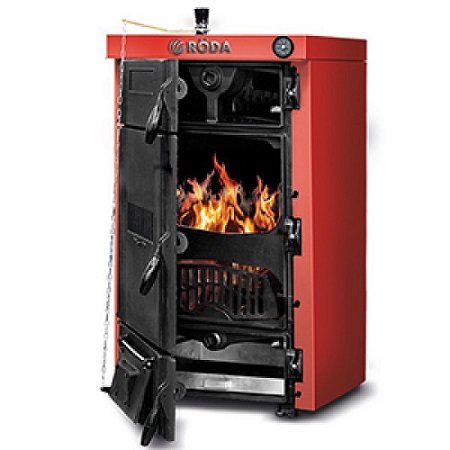

Bottom combustion boiler
The bottom combustion boiler is the most common solid fuel unit, operating primarily on wood and coal. The design of the heat generator includes the following main elements enclosed in the housing: a firebox or combustion chamber, a heat exchanger, supply and return pipes of the heating system circuit, grate, door for loading fuel, door for ignition and cleaning from ash, chimney.
The body of modern boilers is made of steel, and the heat exchanger can be either steel or cast iron. Each type of heat exchanger has its own advantages and disadvantages. Units with a cast iron heat exchanger have a higher corrosion resistance than steel ones. This is an important point, since when solid-fuel heat generators are fired up until the temperature exceeds the dew point, condensate forms in the furnace, which, when mixed with combustion products, is very aggressive to metals. A cast iron heat exchanger is also more fire resistant than a steel one, therefore it has a longer service life. The disadvantages of cast-iron heat exchangers are fragility, high weight, low resistance to temperature changes in the heat carrier in the heating system, they should not exceed 20 ° C.
Usually, cast iron heat generators are divided into separate sections, which facilitates the difficulties in transportation, installation, and in case of failure of one of the sections, it is easy to replace it. Units with a steel heat exchanger are one-piece construction.
In the device of a boiler with bottom combustion, two or three combustion chambers can be provided, which makes it possible to re-burn fuel particles. At the same time, the emission of harmful combustion products into the atmosphere decreases, fuel consumption decreases, and the efficiency of the boiler increases. Modern solid fuel heating boilers allow you to control the combustion process, for which a control system with a fan for air injection is used.
Top combustion boilers
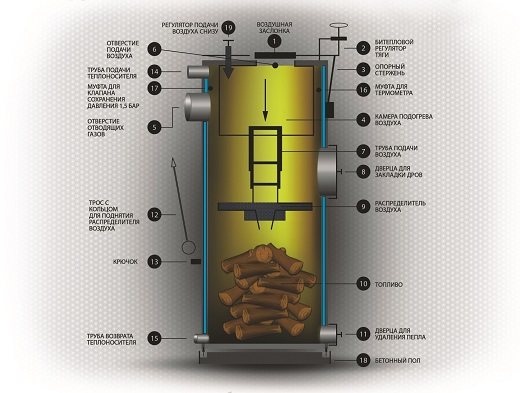

Top combustion boiler
In a unit with upper combustion, the process of burning fuel - coal, firewood, peat briquettes or sawdust - in contrast to a boiler with lower combustion, occurs not from bottom to top, but from top to bottom. This became possible after the invention made and patented by the Lithuanian engineer E. Strupaitis in 2000 and used for the first time in boilers. Combustion in such a heat generator is supported only in the upper layer of the stored fuel, approximately 15 cm thick, where hot air is supplied from above through a special telescopic pipe from a special chamber. As the bookmark burns out, the pipe gradually expands and descends under its own weight, so that the air distributor at the end of the pipe is constantly in the center of the flame.
A wood-fired solid fuel heating boiler with top combustion allows one bookmark to be made every 30 hours, and a coal-fired unit - one bookmark every 5 days. The mode of operation of the heat generator is from one tab to another. That is, after complete combustion of the loaded fuel, it is necessary to remove the formed ash and make a new bookmark.
Top combustion units have a considerable height, but they take up little space in terms of area.
Gas generating (pyrolysis) boilers


Gas generator boiler - scheme of work
Solid fuel gas generating boilers are equipped with 2 combustion chambers. The principle of their work is based on the fact that wood under the influence of high temperature and in conditions of a lack of oxygen turns into charcoal with the release of pyrolysis combustible gas. In one chamber, the usual combustion process first takes place with normal air supply through a special window.After the wood fires normally, the air supply is reduced with the help of the automatic regulator, and the boiler goes into the pyrolysis gas formation mode. The wood smolders slowly, and the released gas rises into the second chamber, where the process of its afterburning takes place.
The efficiency of a gas-generating unit reaches 85-90%, harmful emissions of combustion products into the atmosphere are reduced to a minimum, fuel for such a boiler requires several times less than for a heat generator of direct combustion. In addition to firewood, woodworking waste with a moisture level of no more than 20% can be used as fuel.
Pellet boilers


Pellet boiler with fuel hopper
Pellet boilers run on biofuel made from peat, sawdust, agricultural waste products, compressed into cylindrical granules called pellets. Granules are small in size and sold in convenient packaging for easy transportation and storage.
Pellet boilers are equipped with an automatic control system, including the supply of fuel pellets to the combustion chamber, which is small in size. In this regard, the automation with great accuracy regulates the volume of the supplied fuel, while the most complete combustion is achieved and the production of combustible gases with the maximum temperature is achieved due to the forced injection of air into the combustion area with the help of a fan.
Pellets are loaded into the fuel bunker, from where they are fed into the combustion chamber using the feed system. The bunker can be freestanding or built into the structure of the boiler, the capacity of the bunker for a boiler with a capacity of 20-40 kW, as a rule, is no more than 200-250 kg, which is enough for a week of continuous operation. The feeding system is a screw conveyor driven by an electric motor. If it is necessary to transport pellets over long distances, a pneumatic feeding system can be used.
The automation of pellet heat generators includes mechanical ash removal and self-cleaning systems, the ability to control the temperature in heating pipelines depending on the weather and other devices that facilitate the operation of pellet heating units.
Steam solid fuel boilers
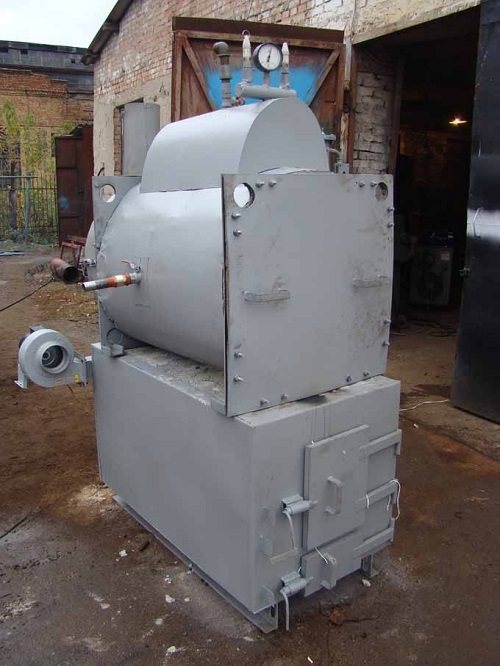

Steam solid fuel boiler
Steam boilers for solid fuels, due to their large power and dimensions, are mainly used in industry to provide steam for technological processes and heating systems. The use of steam solid fuel heat generators is especially effective at enterprises with a large amount of waste suitable for combustion as fuel when it is impossible to use other energy sources. Small power units can also be used for heating homes and other premises for various purposes.
According to the principle of operation, steam boilers are divided into 2 main types: fire-tube and steam-tube.
In a fire-tube unit, combustion products heated to a high temperature during fuel combustion circulate through the pipe system and transfer thermal energy to the water that surrounds these pipes. In this case, water turns into steam and then enters the heating system or through steam pipelines to industrial consumers. Since the generated steam has a high pressure, the walls of such a boiler are made very thick. Therefore, for safety reasons, fire tube boilers have power limitations.
In water-tube boilers, the principle of operation is the opposite - water flows through the pipe system inside the body, heated combustion products circulate around them, as a result, the water in the pipes turns into steam and then goes to consumers. Water tube units are safer, they do not require a large thickness of the walls of the body, which can significantly increase their productivity.
Steam boilers are equipped with automation systems, including devices for fuel ignition and stopping combustion, regulation of water and fuel consumption. The safety group of a solid fuel boiler is of great importance, which includes temperature indicators, safety thermostats, pressure gauges, safety pressure switches and steam pressure valves, other devices and devices that ensure trouble-free operation.
Steam heating and what is it?


When water boils, water vapor is released, which has a large amount of thermal energy. The transfer of energy to the environment occurs at the moment of condensation, in other words, during the transition of water from a vapor state to a liquid state.
In steam heating, the same principle applies. The water boiling in the boiler is fed through pipes to the heating devices, condenses in them and gives off heat. After that, the coolant, which has passed into a liquid state, is fed through pipes to a special storage device. From there, the liquid flows by gravity or forcibly into the boiler.
Pros and cons of steam heating
Steam heating in a private house provides the following advantages:
- Low cost of the device. Profitability in the process of use. The system can be made from a conventional oven, which is especially important for settlements without gasification.
- Since the coolant does not freeze, the system can be used in seasonal residential buildings.
- The efficiency of space heating is increased by radiation of heat energy and convection.
- Small radiators and small pipes can be used to assemble the system, which saves on materials.
- Steam quickly enters every point of the heating system, regardless of its complexity and the size of the house.
- Rapid heating of the premises is an additional advantage.
- The heat transfer coefficient is very high, so heat losses are reduced to zero.
- Such systems can be used in combination with warm floors.
Before carrying out steam heating, you need to study its cons. The disadvantages of steam heating are as follows:
- when circulating along the contour, steam creates noise (to reduce the noise level, copper pipes are laid inside the walls, and the boiler is placed in a separate room);
- heating devices and pipes can heat up to temperatures above 100 ° C, which increases the likelihood of burns when touching the batteries (in this regard, it is recommended to cover radiators and pipes with protective screens);
- in case of a breakthrough, a dangerous emergency situation arises, because the coolant has a very high temperature;
- to assemble the circuit, you will need expensive copper or galvanized pipes (this must be taken into account when calculating how much it costs to carry out steam heating);
- the system is susceptible to corrosion, so its service life is short;
- it is difficult to regulate the temperature in the rooms (for this you have to ventilate the rooms or reduce the amount of fuel, which is quite difficult).
Characteristics and diagram of the device
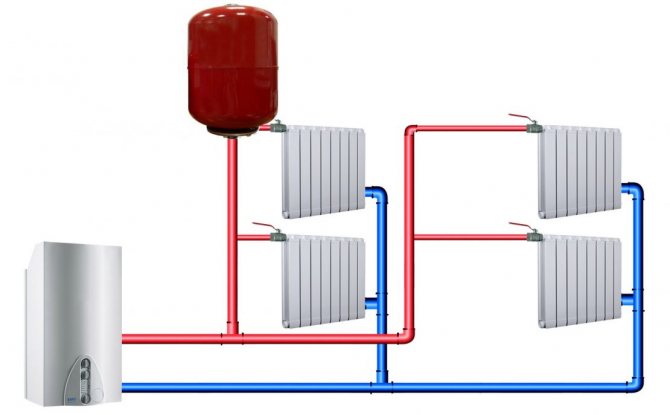

There can be different pressures inside a heating steam system. Depending on this, it can be of the following types:
Air heating system in a private house and industrial premises
- With high pressure over 0.07 MPa.
- With low pressure less than 0.07 MPa.
- The vacuum-steam system has a pressure of at least 0.1 MPa.
Steam heating circuit can be with a closed and open circuit. Low pressure open circuits interact with ambient air. Sealed closed systems are more durable.
Most often, in a private house, closed systems are made with the return of the coolant by gravity to the boiler. Top piping is usually used. If a circuit with a bottom wiring is used, then the pipes are laid with a slope in the direction of steam flow to reduce noise.At the point of condensate drainage, a water seal is made in the form of a loop to protect against steam entering the condensation line.
Important! In steam systems, the steam velocity is maintained within 0.14 m / s, but not higher than this value. Otherwise, the steam will trap particles of condensing moisture, making a loud noise and increasing the likelihood of water hammer.
Less commonly, combined wiring with laying pipelines under the floor of the middle or last floor is used. In this case, the lumen of the return line is completely closed by condensate.
At network pressures above 0.02 MPa, only open circuits are used. In them, air is removed through a condensation accumulator. To protect against steam leaks, water locks or steam traps are installed. A pump is used to transfer the liquid for steam heating from the storage tank to the heat exchanger. This allows the storage tank to be installed below the heat exchanger.
On a note! Steam systems, like water systems, are single-pipe and double-pipe. The first option is suitable for single-storey houses with an area of no more than 80 m². The second option can be used in two-story houses.
Device
The device of a steam boiler is quite complicated. Therefore, assembling a steam boiler with your own hands is not an easy task. Each individual model has its own assembly features. But they are all equipped with the main components:
- Firebox. This is where the fuel is located;
- Ash pan. It serves to collect fuel combustion products;
- Burner. Its tasks are quite clear;
- Economizer. This is a water heater, which we will talk about in more detail;
- Drum. Required for the installation of measuring instruments, piping, fuses;
- Pressure gauge. For the safe operation of the steam unit, the circuit must necessarily include a pressure gauge to monitor the steam pressure.
The installation rules for all steam boilers require that they be located lower than the level of the pipeline and heating devices. So the steam can circulate normally and return condensate from the system.
How the system works
Do not confuse water and steam heating at home. They have many functional differences, despite their superficial similarities.
Both of these types have components:
- boiler;
- radiators;
- pipes.
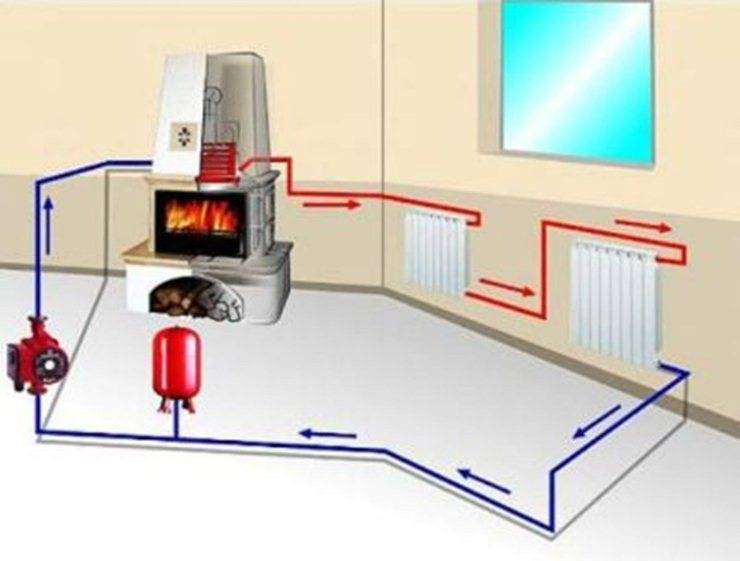

Steam heating is considered effective, you can get by with a small number of batteries
Steam is a heat carrier for steam heating of a private house. You can make such a system with your own hands by following the instructions for assembling and installing components. For a water system, water plays the role of a carrier. The boiler evaporates the water and does not heat it up. The coolant vapors move through the pipes and become a source of a comfortable temperature in the house. The steam cools down inside, after which it condenses. In this case, 1 kg of steam is converted into 2000 kilojoules of heat. For comparison, water cooling by 50 ° C provides only 120 kJ.
The heat transfer of steam is several times higher, which explains the high efficiency of this type of heating. The condensate formed inside the radiator passes into the lower part and moves independently to the boiler. There are several types of heating systems. In this case, the specification is carried out according to the method of returning the coolant, which has been transformed into condensate.
- Closed. There are no contours in this case. Accordingly, the condensate moves through the pipes, which lie at a certain angle. It goes directly into the boiler for further heating.
- Opened. There is a storage tank here. Condensate enters it from the radiators, the pump participates in its re-injection into the boiler.
How to choose the right boiler
To choose the right solid fuel heating boiler, you need to take into account the following factors:
- unit type - with upper or lower combustion, gas generating, pellet or steam, most suitable for the given operating conditions;
- boiler power required for heating and hot water preparation;
- the type of solid fuel to be used;
- the volume of the combustion chamber, on which the frequency of fuel loading will depend;
- heat exchanger material - steel or cast iron, taking into account the merits and negative features of each material;
- the need to connect to power grids, since some models of boilers have devices that operate on electricity - heating elements for maintaining the temperature during the boiler shutdown period, smoke exhausters, fans for air pressurization;
- equipping with automatic control, security units, since solid fuel boilers for the home must be fully provided with all devices and devices for trouble-free operation;
- the possibility of transferring to other types of fuel or using several types.
